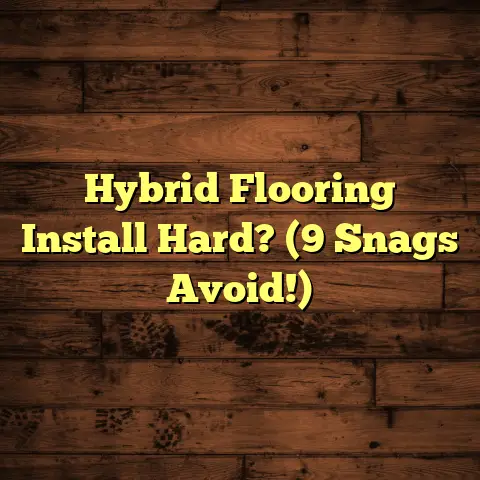Floor Box Sizes & Uses? (3 Min Read Reveals All!)
As a flooring contractor with years under my belt, I’ve seen firsthand how the right floor box can transform a space, both functionally and aesthetically.
In today’s world, we’re all more reliant on technology and electrical devices than ever before. That means we need smart solutions for managing power and data. And that’s where floor boxes come in.
In this article, I’m going to walk you through everything you need to know about floor box sizes and uses. We’ll explore different types, standard sizes, unique applications, and even installation tips.
My goal is to help you choose the perfect floor box solution to optimize your space and keep things safe and organized. Ready to dive in?
Understanding Floor Boxes
So, what exactly is a floor box? Simply put, it’s an enclosure recessed into the floor that provides access to electrical power, data, or communication outlets.
Think of it as an in-floor power strip that’s safe, discreet, and way more functional.
There are generally three main types:
-
Electrical Floor Boxes: These are the most common type, designed to house standard power outlets.
-
Communication Floor Boxes: These handle data and communication connections, like Ethernet, telephone, or AV cables.
-
Combination Floor Boxes: These offer a mix of both power and communication outlets, providing the most flexibility.
Now, let’s talk about what makes up a floor box. They’re more than just a hole in the floor! Here are the key components:
-
Covers: These protect the outlets and keep debris out. You’ll find different styles, from hinged to screw-down, and various materials like metal or plastic.
-
Gaskets: These provide a seal to prevent water or dust from entering the box, especially important in damp or high-traffic areas.
-
Internal Compartments: These separate the different types of wiring (power vs. data) to prevent interference and maintain safety.
Floor boxes are typically made from steel, plastic, or a combination of both. Steel boxes are incredibly durable and offer excellent protection, making them ideal for high-traffic or industrial settings.
Plastic boxes are lighter and more resistant to corrosion, making them a good choice for residential or office environments.
The material you choose will depend on the specific demands of your space.
Floor Box Sizes: An Overview
Alright, let’s get down to the nitty-gritty: sizes. Floor boxes come in a range of sizes to accommodate different needs and applications. Here are some of the most common:
-
Single-Gang Floor Boxes: These are the smallest and most basic, typically designed for a single power outlet or data connection. They’re great for tight spaces or when you only need minimal connectivity.
- Typical Dimensions: 3″ x 2″ x 2.5″
-
Double-Gang Floor Boxes: These offer twice the capacity of a single-gang box, allowing you to install two power outlets, two data connections, or a combination of both.
- Typical Dimensions: 4.5″ x 2.75″ x 2.5″
-
Multi-Gang Floor Boxes: These are the heavy hitters, offering multiple gangs (three or more) for maximum connectivity. They’re perfect for conference rooms, open-plan offices, or any space that requires a lot of power and data access.
- Typical Dimensions: Varies widely, but can range from 6″ x 4″ x 3″ to much larger, depending on the number of gangs.
To give you a clearer picture, here’s a quick reference table:
| Size | Dimensions (Approximate) | Common Use Cases |
|---|---|---|
| Single-Gang | 3″ x 2″ x 2.5″ | Single outlet, small lamp, phone jack |
| Double-Gang | 4.5″ x 2.75″ x 2.5″ | Two outlets, combo power/data, home office |
| Three-Gang | 6″ x 4″ x 3″ | Multiple outlets, conference room, AV setup |
| Four-Gang | 8″ x 4″ x 3″ | High-density connectivity, commercial spaces |
Keep in mind that these are just typical dimensions. Actual sizes may vary slightly depending on the manufacturer and specific model.
When choosing a size, think about what you’ll be plugging in and how many connections you’ll need. It’s always better to err on the side of caution and go a size up if you’re unsure.
Applications of Floor Boxes
Now, let’s talk about where you might actually use these floor boxes. The possibilities are pretty broad, but I’ll break down some common scenarios.
-
Residential Settings: In homes, floor boxes can be a game-changer. Imagine a living room without tangled cords running from the wall to your lamps and electronics. Floor boxes can be strategically placed under sofas, coffee tables, or entertainment centers to provide convenient power access. In home offices, they can keep your workspace clutter-free by providing power and data connections right where you need them.
-
Commercial Environments: Offices are a prime candidate for floor boxes. In open-plan layouts, they eliminate the need for unsightly power strips and extension cords, creating a cleaner and safer environment. Conference rooms benefit from multi-gang floor boxes that can handle multiple laptops, projectors, and other devices.
-
Industrial Applications: Warehouses and manufacturing plants often require heavy-duty power solutions. Floor boxes can provide access to high-voltage power for machinery and equipment, while also keeping cords and cables safely out of the way.
Choosing the right size for each setting is crucial. In a residential living room, a double-gang box might be sufficient for a lamp and a phone charger. But in a conference room, you might need a multi-gang box with a combination of power and data connections to accommodate multiple users.
Planning and layout are key. Before you start cutting into your floor, think about where you’ll need power and data access, and how your furniture will be arranged.
I always recommend creating a detailed floor plan and marking the locations of your floor boxes before you begin installation. This will help you avoid costly mistakes and ensure that your floor boxes are perfectly positioned for maximum functionality.
Specialized Floor Box Designs
Beyond the standard sizes, there are also specialized floor boxes designed for unique purposes. These can be a lifesaver in certain situations.
-
Outdoor Floor Boxes: If you need power access on a patio, deck, or other outdoor space, you’ll need a floor box specifically designed for outdoor use. These boxes are typically made from weather-resistant materials like stainless steel or heavy-duty plastic, and they feature waterproof gaskets and covers to protect against rain, snow, and other elements.
-
High-Traffic Area Floor Boxes: In areas with a lot of foot traffic, like hallways or retail spaces, you’ll want a floor box that can withstand heavy use. These boxes typically have reinforced covers and durable construction to prevent damage from foot traffic, carts, and other equipment.
-
Customizable Floor Boxes: For unique requirements, you can find floor boxes that can be customized to your exact specifications. This might include different outlet configurations, custom finishes, or even integrated AV connections.
When it comes to outdoor applications, waterproof and weather-resistant designs are essential. Look for boxes with a NEMA rating of at least 3R, which means they’re protected against rain, sleet, and snow.
Customizable options are fantastic if you have very specific needs. For instance, I once worked on a project for a recording studio where we needed floor boxes with integrated XLR and TRS connectors for microphones and audio equipment. A standard floor box simply wouldn’t have cut it.
Installation Considerations
Okay, you’ve chosen your floor boxes. Now, how do you actually install them? Here’s a rundown of the installation process:
-
Pre-Installation Planning: Before you even think about cutting a hole in your floor, you need to plan. Determine the exact location of your floor boxes, taking into account furniture placement, electrical needs, and any potential obstructions (like pipes or ductwork).
-
Cutting the Opening: Use a hole saw or jigsaw to cut an opening in the floor that’s slightly larger than the floor box. Be careful not to cut through any wiring or plumbing.
-
Wiring the Box: Connect the wiring to the floor box according to the manufacturer’s instructions and local electrical codes. This is where a professional electrician comes in handy.
-
Securing the Box: Place the floor box into the opening and secure it to the floor using screws or adhesive.
-
Installing the Cover: Attach the cover to the floor box. Make sure it sits flush with the floor and is securely fastened.
The placement of your floor boxes is critical. You want them to be easily accessible but also out of the way of foot traffic.
I always advise my clients to consider the height of their furniture when determining the placement of floor boxes. You don’t want a floor box to be hidden behind a tall piece of furniture or to be a tripping hazard.
For installation, you’ll need some basic tools, including:
- Hole saw or jigsaw
- Screwdriver
- Wire strippers
- Electrical tape
- Voltage tester
And here’s a golden rule: if you’re not comfortable working with electricity, hire a professional electrician. Electrical work can be dangerous, and it’s not worth risking your safety or damaging your property.
Maintenance and Upkeep
Once your floor boxes are installed, it’s important to maintain them properly to ensure their longevity and safety.
-
Regular Inspections: Inspect your floor boxes regularly for any signs of damage, such as cracks, loose covers, or water intrusion. Pay special attention to floor boxes in high-traffic areas, as they’re more likely to be damaged.
-
Cleaning: Keep your floor boxes clean and free of debris. Use a damp cloth to wipe down the covers and remove any dirt or dust.
-
Addressing Common Issues: One common issue is loose or damaged outlets. If you notice that an outlet is loose or not working properly, replace it immediately. Another common issue is water intrusion, especially in outdoor floor boxes. If you see any signs of water damage, dry out the box and repair any leaks or cracks.
Regular inspections are key, especially in commercial settings. I recommend performing a thorough inspection at least once a year.
If you notice any issues, address them promptly. Ignoring a small problem can lead to bigger, more expensive problems down the road.
Conclusion
So, there you have it: a comprehensive guide to floor box sizes and uses. We’ve covered everything from the basic types and sizes to specialized designs and installation considerations.
The key takeaway is that choosing the right floor box can significantly enhance the functionality and aesthetics of your space.
By carefully assessing your specific needs and considering the factors we’ve discussed, you can create a more organized, efficient, and safe environment.
Whether you’re renovating your home, outfitting a new office, or upgrading an industrial facility, the right floor box solution can make a world of difference.
So, take a look around your space. Are you tired of tangled cords and cluttered outlets? Maybe it’s time to consider the power of the floor box.





